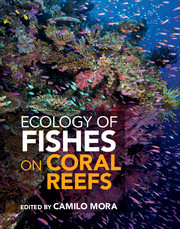Book contents
- Frontmatter
- Contents
- Preface
- Foreword
- List of contributors
- PART I BASIC ECOLOGY
- PART II PATTERNS AND PROCESSES
- PART III HUMAN FINGERPRINTS
- PART IV CONSERVATION
- PART V DEBATES AND PARADIGM SHIFTS
- 23 Is dispersal of larval reef fishes passive?
- 24 Density dependence and independence and the population dynamics of coral reef fishes
- 25 Equilibrial versus non-equilibrial dynamics in coral reef fishes
- 26 Cryptic density dependence: integrating supply-side ecology with population regulation
- 27 Priority effects
- 28 Inverted trophic pyramids
- 29 Shifting baselines in coral reef fishes
- 30 Pluralism explains diversity in the Coral Triangle
- 31 Reef fish biogeographical regions
- 32 Size and sex change
- 33 Quantifying reef fishes: bias in observational approaches
- 34 Seascape ecology of fishes on coral reefs
- 35 The future for coral reef fishes
- 36 Perpetual struggle for conservation in a crowded world and the needed paradigm shift for easing ultimate burdens
- References
- Index
33 - Quantifying reef fishes: bias in observational approaches
from PART V - DEBATES AND PARADIGM SHIFTS
Published online by Cambridge University Press: 05 May 2015
- Frontmatter
- Contents
- Preface
- Foreword
- List of contributors
- PART I BASIC ECOLOGY
- PART II PATTERNS AND PROCESSES
- PART III HUMAN FINGERPRINTS
- PART IV CONSERVATION
- PART V DEBATES AND PARADIGM SHIFTS
- 23 Is dispersal of larval reef fishes passive?
- 24 Density dependence and independence and the population dynamics of coral reef fishes
- 25 Equilibrial versus non-equilibrial dynamics in coral reef fishes
- 26 Cryptic density dependence: integrating supply-side ecology with population regulation
- 27 Priority effects
- 28 Inverted trophic pyramids
- 29 Shifting baselines in coral reef fishes
- 30 Pluralism explains diversity in the Coral Triangle
- 31 Reef fish biogeographical regions
- 32 Size and sex change
- 33 Quantifying reef fishes: bias in observational approaches
- 34 Seascape ecology of fishes on coral reefs
- 35 The future for coral reef fishes
- 36 Perpetual struggle for conservation in a crowded world and the needed paradigm shift for easing ultimate burdens
- References
- Index
Summary
Our understanding of the dynamics of coral reef fish populations has been shaped by our ability to quantify their distribution, abundance, and body size across temporal and spatial scales. These quantifications are, however, subject to biases inherent to sampling methodologies. Here, I review scientific papers published in the last 50 years that address such biases. The most common biases include: fish behavior and observer presence, observer error, sampling method, and transect dimension. While some of these biases can be addressed with the use of distance sampling methods, observer calibration exercises, and available technology, it is important to note that identifying biases and factoring them into our resulting estimates will be fundamental to assessing the reliability of our conclusions and overall improve our understanding of reef fishes.
BIASES QUANTIFYING REEF FISHES
The ecology of fishes on coral reefs has been developed mainly by our ability to quantify the distribution, abundance, and body size of fishes in space and time. There are, however, inherent biases in sampling methodologies that prevent an accurate and precise description of fish communities, making the study of these biases a critical first step in ecology.
Reef fishes are sampled mostly by means of underwater visual censuses (UVC). The most common sampling methods used in UVC include: belt transects (i.e. the observer counts fishes at both sides of a line deployed over the reef; e.g. [343]), stationary point counts (i.e. the stationary observer counts all fishes within a given radius of the field of view; e.g. [132]), line transects (i.e. observer records fish and their perpendicular distance to the transect; e.g. [2487]), towed censuses (i.e. observer records fish while being towed behind a boat; e.g. [700]), and rapid visual censuses (i.e. observer records species and the time at which they are seen; e.g. [319,646]).
Several sources of biases associated with these methods have been mentioned and studied in the reef fish literature, and are reviewed here.
- Type
- Chapter
- Information
- Ecology of Fishes on Coral Reefs , pp. 270 - 273Publisher: Cambridge University PressPrint publication year: 2015
- 7
- Cited by



